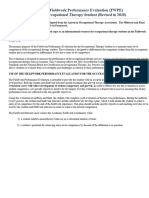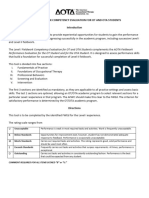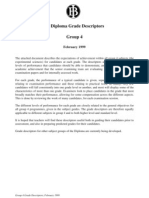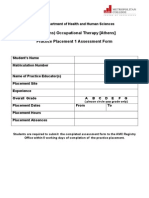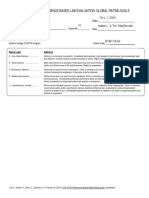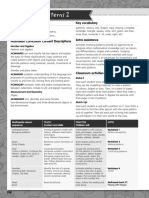Pta Placement Evaluation Form - 2021-2022
Pta Placement Evaluation Form - 2021-2022
Uploaded by
api-584383908Copyright:
Available Formats
Pta Placement Evaluation Form - 2021-2022
Pta Placement Evaluation Form - 2021-2022
Uploaded by
api-584383908Original Title
Copyright
Available Formats
Share this document
Did you find this document useful?
Is this content inappropriate?
Copyright:
Available Formats
Pta Placement Evaluation Form - 2021-2022
Pta Placement Evaluation Form - 2021-2022
Uploaded by
api-584383908Copyright:
Available Formats
Canadian OTA and/or PTA Student
2021-2022 Fieldwork Evaluation Form
Vladyslav Martynchyuk
Student’s Name:
Placement □ Field Placement I ☐ Field Placement II
□ Block Placement
Durham College Advisor
Name: Laura Maybury
Clinical Supervisor’s Name
Alex Giambagno
Clinical Supervisor’s
Designation: 1105 Kingston Rd. E., Unit 11
Name of Facility MedRehab Group Inc
☐OTA
Discipline Focused on ☐PTA
During Placement: ☐OTA & PTA
Ratio OTA:PTA %
☐Acute care ☐Rehabilitation ☐Long Term Care
Facility Setting: ☐Day Hospital ☐Community ☐Out-patient clinic
☐Other:
Client Population ☐Paediatric ☐Adult ☐Geriatric ☐Other:
Check all that apply
☐MSK ☐Mental Health ☐Respiratory ☐Endocrine
Client Category ☐Neuro ☐Cardiac ☐Oncology ☐Transplant
Check all that apply
☐Multiple Systems ☐Other:
Submission of the Preceptor’s evaluation form to the Program Coordinators
Via email (word and PDF versions of the form are available
Please note:
1) All signatures are required on page 10 to authenticate this evaluation. Advise the program coordinator if you
require assistance with the form, submission or electronic signature(s).
2) For tracking hours please sign the Attendance Form daily (a sample of this document is located on pg. 11).
Students are responsible to log and submit final electronic copies of the attendance forms noting and totaling ALL
hours completed, signed by the preceptor to demonstrate successful completion of all placement hours – this must
be received within 24 hours following placement completion,
3) Passing grades: Field Placement 1 = score of 2 or above; Field Placement II = score of 3 or above;
Block/Consolidation Placement = score of 4 or above for each competency area
Revised March 30, 2020
Expectations for Student Performance
Competencies describe the general abilities required to accomplish the main tasks, functions and/or roles of
an OTA and/or PTA. They focus on the skills, knowledge and attitudes required to deliver optimal client-
centered care in a safe, ethical and effective manner. For each competency, there are examples of
performance indicators to help guide your evaluation. There may be other performance indicators specific to
your clinical setting that you will consider in your rating.
To complete the form:
For each competency identified, evaluate the student’s competency using the 5-point rating scale below.
When rating their performance, the scores should reflect the level of their competency at the time of
evaluation, at midterm and final weeks. Provide comments to support rating selected and any
recommendations for areas, student may need to work on to improve or consolidate their learning.
Rating Scale:
Competency Rating Scale & Descriptors Required
Passing grades: FPI = 2 or above; FPII = 3 or above; Block = 4 or above for each competency area Grade
Student can consistently and reliably perform competency/skill Block
5 Independent independently at entry-level1 practice, following clinical supervisor’s 4 or above
instruction, within this specific practice setting.
Student can perform the competency/skill with occasional (minimal) Block
Approaching
4 guidance, support, and/or direction from Clinical Supervisor (OTA/OT 4 or above
independence
and/or PTA/PT)
Student demonstrates significant gains in the acquisition of skills and FP II
Acquiring
3 knowledge related to the role. Student can perform competency/skill 3 or above
independence
with regular (moderate) guidance, support, and/or direction
Student demonstrates a basic understanding of skills and knowledge FP I
Emerging
2 related to the role. Student can perform competency/skill with 2 or above
independence
continuous (maximum) guidance, support, and/or direction
Student demonstrates poor /a lack of understanding of skills and Unsuccessful
1 Unsatisfactory knowledge related to the role. Student unable to perform
competency/skill without direct cueing.
Discussing the evaluation
The clinical supervisor should meet with the student to discuss the contents of the evaluation and
areas of strength and areas requiring improvement.
Students should contribute to this discussion by completing this form as a self-evaluation priorto
meeting with the clinical supervisor.
This provides an opportunity for student to have an understanding of how they are performing and
areas to work on to develop their competencies as an OTA & PTA.
1 An entry level OTA and PTA is defined as clinician who is a recent graduate of an OTA and/or PTA program and who is in the early
stages of their career (example, within the first 3 - 6 months of practice).
Revised March 30, 2020
Rating Scale: 5: Independent, 4: Approaching independence, 3: Acquiring independence,
2: Emerging independence, 1: Unsatisfactory
Professionalism & Accountability
Midterm 4
Practices within scope of professional parameters and personal abilities
Examples of Performance Indicators: Performs within the scope of the OTA
and/or PTA role. Works within their role as a therapist assistant student and 5
Final
within personal abilities and limitations. Seeks support / assistance
appropriately. Asks appropriate questions. Follows supervision and
communication guidelines.
Takes responsibility for service components as assigned
Midterm
4
Examples of Performance Indicators: Prioritizes assigned duties and resources
appropriately. Demonstrates effective time management skills. Final
4
Midterm 4
Demonstrates professional behaviors
Examples of Performance Indicators: Exhibits respect, initiative and enthusiasm.
Follows workplace expectations (e.g. policies and procedures, hours of work, Final 4
attire, hygiene, use of technology). Assumes responsibility for own actions.
Maintains appropriate boundaries in therapeutic and professional relationships.
Midterm 3
Engages in self-reflection
Examples of Performance Indicators: Identifies strengths and areas for
improvement. Accepts constructive feedback and integrates recommendations 4
Final
into practice. Develops and implements learning strategies using appropriate
resources.
Professionalism & Accountability Comments:
I try to meet all the requirements of a virtuous student, I am not late, I follow the treatment, and
I do not interfere with it. I help if I am asked, and I try not to inconvenience.
In the final stage of the placement, I meet all the requirements: not late, follow the treatment
and don't interfere with it. Try to be helpful and not inconvenience
Revised March 30, 2020
Rating Scale: 5: Independent, 4: Approaching independence, 3: Acquiring independence,
2: Emerging independence, 1: Unsatisfactory
Communication & Collaboration
Midterm 4
Communicates in a Professional Manner
Examples of Performance Indicators: Establishes rapport. Adapts
communication strategies to reduce communication barriers and support
diversity (e.g. considering education, culture, age and gender). Promotes optimal Final 4
client and team performance (e.g. cueing, providing feedback with dignity and
empathy, listening, guiding)
Midterm 3
Uses communication skills effectively
Examples of Performance Indicators: Clearly and accurately exchanges verbal
information (e.g. speaks with a clear, audible voice, confirms understanding,
actively listens). Recognizes, utilizes and responds to non-verbal cues. Uses 3
Final
language and terminology suited to the interaction. Uses written communication
in a timely and accurate manner according to workplace expectations (e.g.
documenting in clients’ charts, caseload log, taking messages, emails, flow
sheets).
Midterm
Collaborates with Inter-professional Team 4
Examples of Performance Indicators: Recognizes roles of team members.
Participates actively as a team member to optimize client care and provide Final 4
continuity in service delivery. Consults with/reports to the appropriate team
member. Identifies and manages conflict.
Communication and Collaboration Comments:
I got in touch with all the team members. This was easy to do because they are all very nice
people. They give advice and are understanding if something doesn't work out.
In the final stage of the placement, I keep a good relationship with the clinic members. I'm
keeping get advice for them, and they're very nice to me
Revised March 30, 2020
Rating Scale: 5: Independent, 4: Approaching independence, 3: Acquiring independence,
2: Emerging independence, 1: Unsatisfactory
Treatment Implementation
Midterm 3
Performs assigned therapeutic interventions (direct patient care)
Examples of Performance Indicators: Applies safe practices in the workplace
(e.g. follows precautions and contraindications, proper body mechanics,
equipment safety). Explains therapeutic benefits of treatment specific to client.
Participates in client education. Implements therapeutic intervention using a Final 3
client-centred approach. Follows the timing, frequency, location and duration of
interventions. Monitors and addresses client’s response to treatment. Contributes
to treatment planning (e.g. data collection, treatment progressions and
modifications). Brings session to a close.
Midterm 4
Performs assigned therapeutic interventions (indirect patient care)
Examples of Performance Indicators: Appropriate set up, clean up and follow up
as per client needs and facility protocol. Prepares for intervention (e.g. chart
review, understands therapeutic goals and treatment plan, gathers equipment,
Final
environmental scan, follows precautions and contraindications). 4
Demonstrates critical thinking Midterm 3
Examples of Performance Indicators: Integrates knowledge (e.g. anatomy,
physiology, pathology) into practice. Recognizes need for, and seeks assistance
or clarification when appropriate. Responds appropriately to ethical and moral
dilemmas. Demonstrates effective problem-solving (e.g. identifies problems, 3
Final
determines possible options, recognizes risks, implement solution, reflect and
revise). Analyzes and interprets information accurately (e.g. chart review)
Protects the client from harm Midterm 4
Examples of Performance Indicators: Obtains client’s informed consent prior to
performing assigned tasks. Maintains client/family and organizational
confidentiality. Takes precautions to ensure the client’s safety and dignity (e.g.
safe use of equipment, infection control, correct handling techniques, draping, 4
Final
privacy)
Treatment Implementation Comments:
I still have difficulty with the independant treatment and deadlines, but I can find solutions to
problems if necessary. I follow the accompanying measures during treatment and follow the
patients.
In the final stage of the placement, I began to feel more confident working with the equipment
and communicating with customers, but I still needed support and advice on some questions.
Revised March 30, 2020
Rating Scale: 5: Independent, 4: Approaching independence, 3: Acquiring independence,
2: Emerging independence, 1: Unsatisfactory
Organization of Service Delivery
Midterm 4
Performs non-clinical duties
Examples of Performance Indicators: Organizes and maintains equipment,
supplies, and written resources. Completes administrative tasks (e.g. workload Final 4
measurements, scheduling, quality improvement initiatives, inventory).
Participates in education of team members, peers, and other learners as
assigned.
Organization of Service Delivery Comments:
I prepare equipment and rooms for patients, connect and disconnect equipment myself.
In the final stage of placement, I do it more confidently
Revised March 30, 2020
Midterm Summary
Performance at Midterm:
Exemplary Satisfactory Unsatisfactory (explain below)
General Comments:
Some areas require improvement and improve slowly during the placement; some areas
are getting better faster. I feel progress because of the help of employees. I also became
more confident with patients, and now there is no such stress as before.
Strengths:
I would call the strengths of this communication with the patients. I try to find an approach
to each of them.
Areas for growth:
I need to improve my skills in demonstrating exercises and anatomy.
The midterm evaluation was reviewed with the student
Clinical Supervisor(s): Date
Print Name / Designation Signature
The midterm evaluation was reviewed with the clinical supervisor
Student Print Name Signature
Student was well prepared for this placement. Yes No
If no, please indicate areas of insufficiency.
Comments:
Reviewed May 11, 2020
Final Summary of Evaluation of Clinical Competencies
To be completed at the end of the placement only.
General Comments:
I feel more confident in all the activities I have done during my placement. I understood how
this happens that each client is individual and needs a personal approach. Staff also play an
essential role in the work atmosphere.
Strengths:
I would call this communication with patients. Not all patients are open people, but I always try
to be nice and polite to them.
Areas for growth:
I need to increase my knowledge in the field of exercises, learn more ways to work on this or
that part of the body and improve my understanding of anatomy
Attendance: No. of days No. of days Total hours completed at placement: 152
absent: late:
Profession allocation of OTA:PTA
%: %
Reason for absence:
Overall Performance on this Placement:
Exemplary Satisfactory Unsatisfactory (explanation required)
Clinical Supervisor(s):
Print Name / Designation Signature Date
Assigning OT or PT
Print Name / Designation Signature Date
Student signature verifies that the evaluation was reviewed with evaluator(s)
Print Name / Designation Signature Dat
Reviewed May 11, 2020
You might also like
- Aota Fieldwork Performance EvaluationDocument6 pagesAota Fieldwork Performance Evaluationapi-699389850No ratings yet
- Early Childhood Trainer Competency Self AssessmentDocument3 pagesEarly Childhood Trainer Competency Self AssessmentZoe BrownNo ratings yet
- Ota Field Placement Evaluation Form - 2022-2023Document9 pagesOta Field Placement Evaluation Form - 2022-2023api-584383908No ratings yet
- Mask Fit Test 1Document1 pageMask Fit Test 1api-584383908No ratings yet
- Canadian Ota Pta Fieldwork Evaluation Form - Durham College - 2017-2018 Copy 2Document12 pagesCanadian Ota Pta Fieldwork Evaluation Form - Durham College - 2017-2018 Copy 2api-387804028No ratings yet
- Meeting the Assessment Requirements of the Award in Education and TrainingFrom EverandMeeting the Assessment Requirements of the Award in Education and TrainingNo ratings yet
- CSS Essays OutlinesDocument18 pagesCSS Essays OutlinesAr NaseemNo ratings yet
- SUMMER TRAINING REPORT PallviDocument32 pagesSUMMER TRAINING REPORT PallviKavindra VermaNo ratings yet
- Final Evaluation 1Document9 pagesFinal Evaluation 1api-659065431No ratings yet
- Final Placement Evaluation 1Document9 pagesFinal Placement Evaluation 1api-659065431No ratings yet
- First Placement EvalDocument9 pagesFirst Placement Evalapi-659065431No ratings yet
- Bowmanville Physiotherapy EvalDocument9 pagesBowmanville Physiotherapy Evalapi-658308760No ratings yet
- Taunton Mills Alana Review FinalDocument9 pagesTaunton Mills Alana Review Finalapi-658308760No ratings yet
- Ashleigh Cole Canadian Ota Pta Fieldwork Evaluation Form - Durham College 2016-2017Document14 pagesAshleigh Cole Canadian Ota Pta Fieldwork Evaluation Form - Durham College 2016-2017api-395143739No ratings yet
- Ota Pta Fieldwork Evaluation FormDocument14 pagesOta Pta Fieldwork Evaluation Formapi-395143739100% (1)
- HeliasDocument12 pagesHeliasapi-387804028No ratings yet
- Ot Evaluation On Placement - The Village of Taunton Mills - Rahim VirjiDocument10 pagesOt Evaluation On Placement - The Village of Taunton Mills - Rahim Virjiapi-584598939No ratings yet
- Final Draft Student Clinical LogbookDocument142 pagesFinal Draft Student Clinical LogbookdalhatawalNo ratings yet
- Dreams TherapyDocument4 pagesDreams Therapyapi-234072677No ratings yet
- Course 5 Clinical EvaluationDocument10 pagesCourse 5 Clinical EvaluationAliSabitNo ratings yet
- Final Draft Student Clinical LogbookDocument143 pagesFinal Draft Student Clinical Logbookرافت العواضيNo ratings yet
- MG Empowering People With A Disability (ID 97346)Document44 pagesMG Empowering People With A Disability (ID 97346)amir abbasi100% (1)
- Final EvalDocument5 pagesFinal Evalapi-282753416No ratings yet
- EvaluationmsiDocument7 pagesEvaluationmsiapi-365022171No ratings yet
- Progress ReportDocument4 pagesProgress Reportdileepa RathnayakaNo ratings yet
- Detail 55934 4963418Document8 pagesDetail 55934 4963418api-725271439No ratings yet
- Clinical Placement III Clinical Assessment Form PDFDocument4 pagesClinical Placement III Clinical Assessment Form PDFA ANo ratings yet
- Danielleruiz-Fwpe 1Document3 pagesDanielleruiz-Fwpe 1api-700593200No ratings yet
- ch1 Clinical EvaluationDocument2 pagesch1 Clinical Evaluationapi-696815516No ratings yet
- Evaluation Completed - DRDocument2 pagesEvaluation Completed - DRapi-679742031No ratings yet
- Psych Clinical Rotation EvaluationDocument3 pagesPsych Clinical Rotation Evaluationapi-740251080No ratings yet
- Select PhysicalDocument5 pagesSelect Physicalapi-234072677No ratings yet
- Semester 4 EvalDocument4 pagesSemester 4 Evalapi-239573049No ratings yet
- Eval55703411 GerinetDocument5 pagesEval55703411 Gerinetapi-282751948No ratings yet
- Projectnurse UsfDocument19 pagesProjectnurse Usfapi-324392818No ratings yet
- Projectnurse UsfDocument7 pagesProjectnurse Usfapi-335042704No ratings yet
- BSBHRM413 Student Assessment V1.0Document20 pagesBSBHRM413 Student Assessment V1.0n.phuonganh0509No ratings yet
- Medsurg II Clinical EvaluationDocument9 pagesMedsurg II Clinical Evaluationapi-316376632No ratings yet
- Appendix 9Document1 pageAppendix 9sesaeedhaniyah.dNo ratings yet
- Clinical Evaluation Jp-RachelDocument8 pagesClinical Evaluation Jp-Rachelapi-726698459No ratings yet
- Competency FrameworkDocument12 pagesCompetency FrameworkconeshaNo ratings yet
- Level I Fieldwork Competency Evaluation For Ot and Ota StudentsDocument5 pagesLevel I Fieldwork Competency Evaluation For Ot and Ota Studentsapi-699389850No ratings yet
- Rialyn Palma ID # 1038027 R: September 12, 2013Document9 pagesRialyn Palma ID # 1038027 R: September 12, 2013api-323533301No ratings yet
- Laep Midpoint t3 Fall 2021 Elise MannDocument6 pagesLaep Midpoint t3 Fall 2021 Elise Mannapi-594366475No ratings yet
- scn625 Summativeeval SarahltDocument6 pagesscn625 Summativeeval Sarahltapi-644817377No ratings yet
- Grade DescriptorsDocument3 pagesGrade DescriptorsbananacrunchNo ratings yet
- BSBHRM413 Student Assessment V1.0Document30 pagesBSBHRM413 Student Assessment V1.0n.phuonganh0509No ratings yet
- ADPP1 - Assessment - Report - Form - Final05042011Document17 pagesADPP1 - Assessment - Report - Form - Final05042011Adonis GaleosNo ratings yet
- Clinical 2Document2 pagesClinical 2api-679675055No ratings yet
- Anahyguillen Integrity House EvaluationDocument3 pagesAnahyguillen Integrity House Evaluationapi-701420672No ratings yet
- Editha Custodio Nur4216lDocument7 pagesEditha Custodio Nur4216lapi-335042704No ratings yet
- Info Sheet Group 3Document29 pagesInfo Sheet Group 3Mary An EijansantosNo ratings yet
- Clinical Evaluation CH2Document2 pagesClinical Evaluation CH2paigemott11No ratings yet
- GTLMH Nursing Evaluation ToolDocument2 pagesGTLMH Nursing Evaluation ToolabcalagoNo ratings yet
- SAQA - 115431 - Learner GuideDocument21 pagesSAQA - 115431 - Learner GuidenkonemamakiNo ratings yet
- SITXFSA006 Assessment WorkbookDocument55 pagesSITXFSA006 Assessment Workbookindermaan706No ratings yet
- Managing Performance ConcernsDocument17 pagesManaging Performance ConcernsN VNo ratings yet
- Mom Baby Clinical Rotation EvaluationDocument2 pagesMom Baby Clinical Rotation Evaluationapi-740251080No ratings yet
- Public Health Final EvaluationDocument2 pagesPublic Health Final Evaluationapi-679663498No ratings yet
- A5 QuestionnaireDocument9 pagesA5 QuestionnaireThadz AmbrosioNo ratings yet
- NUR 420 Practicum Midterm Practicum Progress DocumentDocument9 pagesNUR 420 Practicum Midterm Practicum Progress DocumentBrooke GagnonNo ratings yet
- Chad Mid-Year EvaluationDocument5 pagesChad Mid-Year Evaluationapi-210400076No ratings yet
- Tiffanyfinal DraggedDocument1 pageTiffanyfinal Draggedapi-732295056No ratings yet
- Workers Health and Safety Awareness in 4 Steps Training Module 202143Document1 pageWorkers Health and Safety Awareness in 4 Steps Training Module 202143api-584383908No ratings yet
- Diversity Self-Awareness and Action 202143Document1 pageDiversity Self-Awareness and Action 202143api-584383908No ratings yet
- Workplace Violence and Harassment Prevention Training Module 202143Document1 pageWorkplace Violence and Harassment Prevention Training Module 202143api-584383908No ratings yet
- Cover LetterDocument1 pageCover Letterapi-584383908No ratings yet
- Health and Ssfety ChecklistDocument1 pageHealth and Ssfety Checklistapi-584383908No ratings yet
- Ota Smart GoalsDocument1 pageOta Smart Goalsapi-584383908No ratings yet
- Mock InterviewDocument2 pagesMock Interviewapi-584383908No ratings yet
- Ota Clinical Skill PassportDocument6 pagesOta Clinical Skill Passportapi-584383908No ratings yet
- Lab Critique Self ReflectionDocument4 pagesLab Critique Self Reflectionapi-584383908No ratings yet
- 201702201702571.definisi Kurikulum Dan PengajaranDocument34 pages201702201702571.definisi Kurikulum Dan Pengajaranbba5022100% (2)
- Models of CurriculumDocument15 pagesModels of CurriculumHemantNo ratings yet
- Lesson 37 - Patterns 2: Learning Objectives Key VocabularyDocument5 pagesLesson 37 - Patterns 2: Learning Objectives Key VocabularydalNo ratings yet
- Chapter 10 - Education and Skill DevelopmentDocument16 pagesChapter 10 - Education and Skill Developmentdivya44766No ratings yet
- Presentation To IT Teachers On ECCB Sponsored STEM Summer Camps 2024Document32 pagesPresentation To IT Teachers On ECCB Sponsored STEM Summer Camps 2024pomira5219No ratings yet
- Jenalyn M. Pino: Career ObjectiveDocument2 pagesJenalyn M. Pino: Career ObjectiveMike OngNo ratings yet
- Activity Completion Report: Department of EducationDocument4 pagesActivity Completion Report: Department of EducationAngela Maniego MendozaNo ratings yet
- Oral Reading Test LPDocument2 pagesOral Reading Test LPdonabelle mianoNo ratings yet
- CLinical Skills Thesis FinalDocument32 pagesCLinical Skills Thesis FinalcarouselNo ratings yet
- Selection Committee Directorate of Medical Education, Chennai-10Document4 pagesSelection Committee Directorate of Medical Education, Chennai-10Jagan NathanNo ratings yet
- 36 SCHOLARSHIPS Compiled by UG Scholarship GroupDocument8 pages36 SCHOLARSHIPS Compiled by UG Scholarship GroupFranc-junior FokaNo ratings yet
- Registration Form: O-A Levels/ Matriculation & AboveDocument3 pagesRegistration Form: O-A Levels/ Matriculation & AbovekksdksNo ratings yet
- 1303 Preschool Teacher Interview Questions Answers GuideDocument8 pages1303 Preschool Teacher Interview Questions Answers Guideabbasafridi143143No ratings yet
- Monograph Pamplet PDFDocument2 pagesMonograph Pamplet PDFReylanAquinoNo ratings yet
- Iusd Math HomeworkDocument7 pagesIusd Math Homeworkb0nuz1pybaz3100% (1)
- U.N. Special Session On Children: Newsletter Newsletter Newsletter Newsletter NewsletterDocument8 pagesU.N. Special Session On Children: Newsletter Newsletter Newsletter Newsletter NewsletterRc Red-MacNo ratings yet
- Beyond The GavelDocument58 pagesBeyond The GavelRaza RaheemNo ratings yet
- Montei ResumeDocument3 pagesMontei Resumeapi-602736707No ratings yet
- 4 Learning To LeadDocument6 pages4 Learning To LeadnicksNo ratings yet
- GEP 2023 Final Approved Circulated 10-07-23Document34 pagesGEP 2023 Final Approved Circulated 10-07-23Adnan MatiullahNo ratings yet
- WORKSHOP 2 DLL - 4th QRTR - Week 1.docx Institutional OutcomesDocument8 pagesWORKSHOP 2 DLL - 4th QRTR - Week 1.docx Institutional OutcomesShalom FoxtrotNo ratings yet
- Accomplishment Report March2022Document14 pagesAccomplishment Report March2022Jennelyn SulitNo ratings yet
- My Homework Lesson 4 Arrays and MultiplicationDocument6 pagesMy Homework Lesson 4 Arrays and Multiplicationafmtqdkpe100% (1)
- DLL - Ethical Use of InformationDocument3 pagesDLL - Ethical Use of InformationKiennia Flor Amasola GilNo ratings yet
- Introduction of SchoolDocument25 pagesIntroduction of SchoolRanjeet RajputNo ratings yet
- Applying BloomDocument10 pagesApplying BloomAbdul Razak IsninNo ratings yet
- Oral Com (Pre Test) Item AnalysisDocument20 pagesOral Com (Pre Test) Item Analysiszitadewi435100% (1)
- Republic of Rwanda PDFDocument4 pagesRepublic of Rwanda PDFAlexis TwizerimanaNo ratings yet
